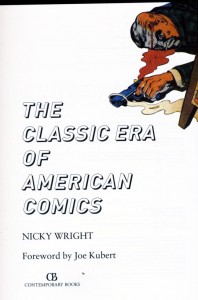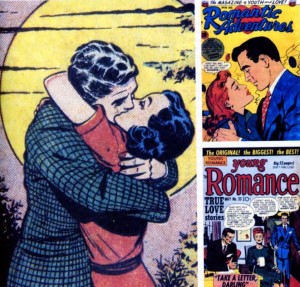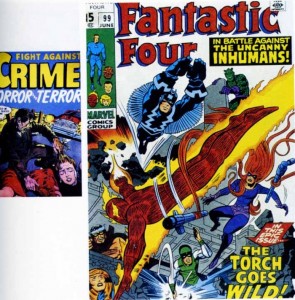Review: Leaping Tall Buildings: The Origin of American Comics
By Christopher Irving with pictures by Seth Kushner
$23 from Amazon.
[EDITOR’S UPDATE: Mr. Irving contacted Barry to comment on this review after it was originally posted, and Barry has requested me to update the paragraph about the source of Irving’s quotes accordingly, as well as add a link to his website and upgrade the book’s overall grade score. We thank Mr. Irving for his input and welcome feedback from authors we review.–Roy]
This mediocre book is a disappointment on many levels. First, it is NOT the origin, in any sense of the American Comic and it is a mystery to me why they chose that as a subtitle. There is a lot less here than meets the eye. What Irving attempts to do is give a snapshot, sometimes literally, of a specific time in the artist’s life, not his entire career. While history is often biography, randomly chosen biographies do not always make history.
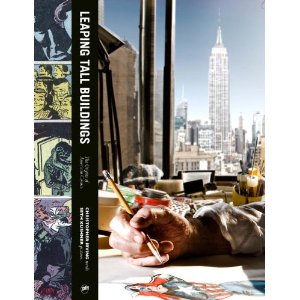
Leaping Tall Buildings: The Origins of American Comics
What this contains, is brief, encyclopedic entries of about 55 people who have contributed to the comic book industry from Siegel and Shuster’s Superman (1938) until the digital artists of today. The selections are rather random and there is no explanation why these people were chosen. Why was Gene Colan included, but John Romita or John Buscema were not? Why no Carmine Infantino, Wally Wood, Bob Kane, Al Feldstein, Graham Ingles, Gil Kane, and how could this ever be a history without so many of these people? Very many of the 55 are contemporary.
Generally, there is a wonderful, new or unseen photograph of the subject, followed by a two or three page biography, although some, like Jim Shooter, only get one page. These bios also contain small pictures of their published or original artwork, often too small to enjoy on such a small page.
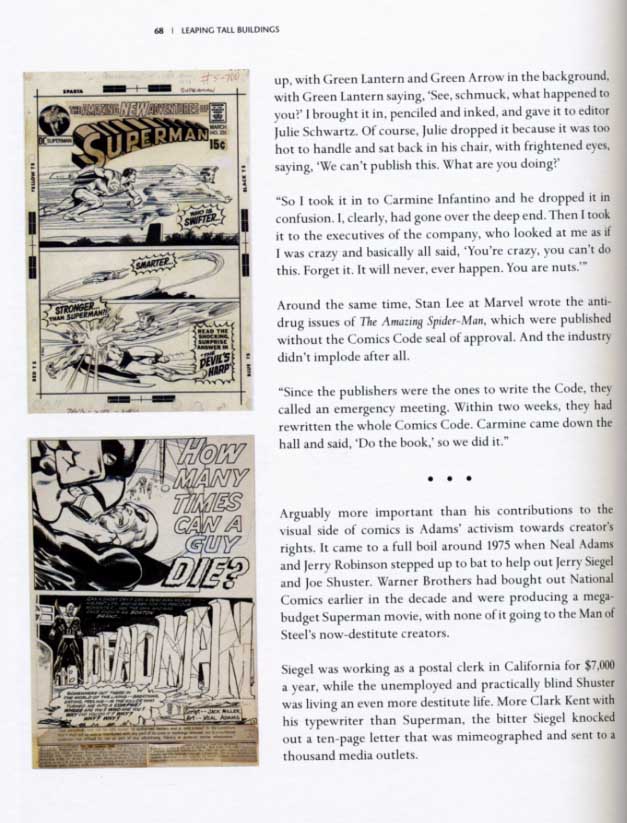
While Jack Kirby is given less than one and a half pages, Walt Simonson is given two pages, and Brian Michael Bendis gets almost three.
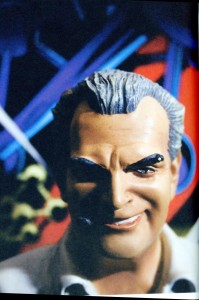
Mr. Irving had worked on this book for four years and has worked in the comics trades for close to fifteen years, during which time he conducted these interviews. Much more material can be seen at:
In general, the author will highlight only ONE aspect of a creator’s portfolio and life, as if he contributed a small, but important amount. But there is NEVER a connection to history, nor an attempt to give a real presentation of one. Eisner’s work boils down, of course, to solely being about the Spirit and his design to have the character use a mask; Joe Kubert discuss mostly his work inking the Flash and his school; Howard Chaykin apparently did nothing before 1985 and Alex Ross only drew Marvels and Kingdom Come.
The disappointing Gene Colan section is an example of why the book disappointed me. Only Tomb of Dracula is largely discussed, and Howard the Duck is briefly mentioned, but not his work on Iron Man, Daredevil, or anything he did during the 1960s, or away from Marvel.
But I do not believe this book was greatly researched. For example, in discussing Denny O’Neil, for example, they discuss the work he did on Green Lantern/Green Arrow, they say he was brought in on a failing book and made it successful. Well, GL was cancelled 13 issues later, while O’Neil was still writing it. Irving says “Stan Lee and (Steve) Ditko parted ways over the identity of a super-villain.” This is so not true, there is no substantiation of it anywhere. Steve Ditko has written about it in Robin Snyder’s The Comics. Lee and Ditko both acknowledge that had not been speaking to each other for a year, how they could argue over anything? But this is a rumor that continues due to a lack of research. This takes away from the credibility of the book.
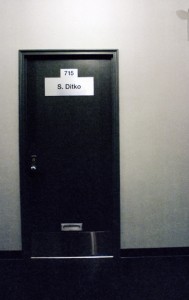
I enjoyed the chapter on Joe Quesada and a couple of people who had more than three pages.

I liked the piece on how All Jaffee created those wonderful MAD fold-ins. Many of the photographs were just terrific, but the small artwork marred the visual look of this 8 x 1.2 x 10, 240 page book. But overall, the book gets a C+.
If you are looking for a real history of comics, may I suggest two?
First, and I will do a full review later, Jim Steranko’s History of the Comics, volume I and II give great insight into the Golden Age of Comics.
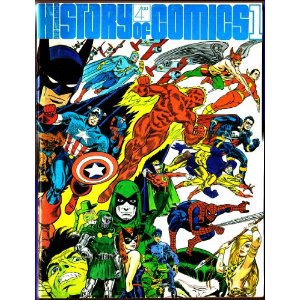
The Steranko History of Comics, Volume 1
Then there is The Classic Era of American Comics by Nicky Wright. It begins where comic books almost ended: with Fredrick Wertham, Seduction of the Innocent and the congressional hearings that followed the publication of that book. When the writer address the history of a specific character in comics they briefly go over the history of comics. Mr. Wright and Mr. Kubert take their time and give a much fuller history of the events that created comic books. Also included are many colorful old pictures of comic strips, and later, comic books. Dividing the book into sections, they not only cover the very beginning of comics that we know, but comics that have been forgotten. Also included are sections of animal comics, jungle comics with “Good Girl Art” and many other forms that have come and gone. All with splendid pictures.
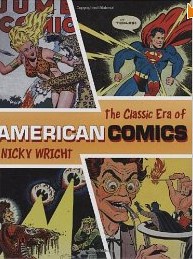
The Classic Era of American Comics
But the most important aspect of this book was context. Often glossed over, Mr. Wright emphasizes the role Fredrick Wertham had in ending an era of comics. In his book, Seduction of the Innocent published in 1955, Mr. Wertham contended that comic books were evil. He claimed Superman was a Nazi. He also claimed that Batman and Robin were gay and just reading about them caused children to become gay. Most important, he claimed that reading comics caused juvenile delinquency. A major target, of course, was the EC horror comics. In this very balanced book, Mr. Wright and Mr. Kubert show some of the artwork that should have been aimed for an adult audience. Soon, congressional hearings were held and congress forced the industry to censor itself. The censorship was so heavy it almost destroyed the industry. Rather than just going after ghouls and goblins, or giving a rating system that would put adult comics out of the reach of children, the new Comics Code went after ideas such as civil rights, anti war sentiments and the evils of drug use. It took 15 years before an anti-drug theme could return to comics. It certainly ended an era.
I had two, small disappointments with the book. Often the author would refer to specific covers or events but not reprint them. Basil Wolverton’s MAD covers and Mac Raboy’s Captain Marvel Jr. covers are two examples. Also, much of the artwork did not give creative credit to the artists who drew them and sometimes the year was left out. But I discovered from one of Mr. Wright’s friends, that he had passed on before he was able to finish these aspects of the book. These should be considered minor points.
